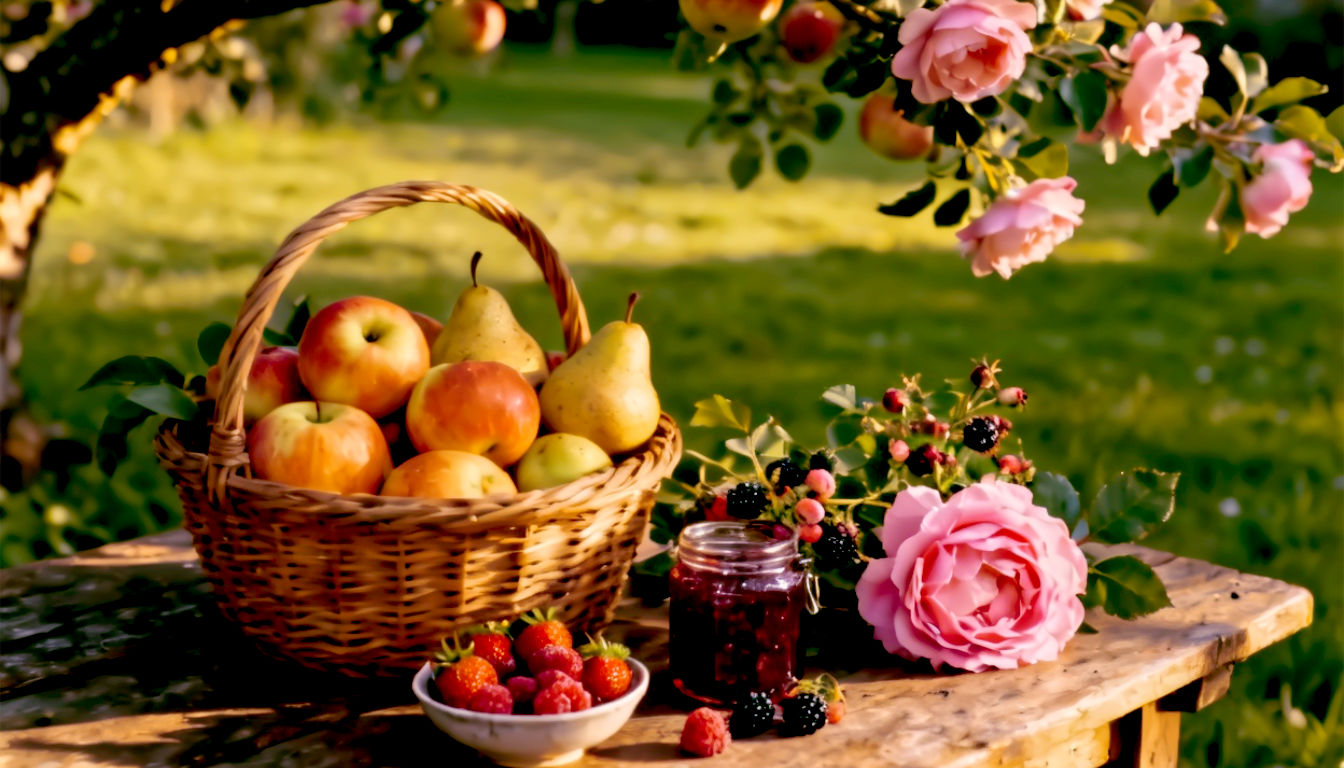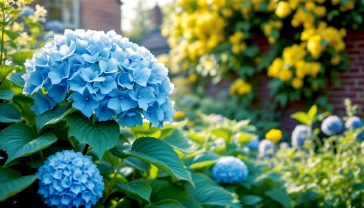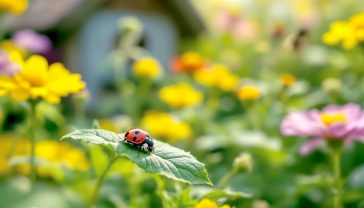Beyond the Bramble: Guide to the Rose Family (Rosaceae)
An ultimate guide to the Rosaceae family for a British audience. Explore the plants, from apples to wild roses, that define our landscape and culture.

This post may contain affiliate links. If you make a purchase through these links, we may earn a commission at no additional cost to you.
Ever bitten into a crisp apple, admired a blooming rose in a classic English garden, or picked wild blackberries on a summer walk? If you’ve done any of these, you’ve had a close encounter with the Rosaceae family. It’s one of the most important and beloved plant families on the planet, and here in Britain, it’s woven into the very fabric of our landscape, our kitchens, and even our history.
You might not know it by name, but the Rose family is everywhere. It gives us juicy strawberries for our Wimbledon cream teas, cherries for our Bakewell tarts, and the apples that fill our crumbles. It’s the wild roses scrambling through our hedgerows and the elegant ornamental trees lining our suburban streets.
But what exactly is the Rosaceae family? How can a thorny blackberry bush be related to a towering cherry tree? And why has this one group of plants become so vital to us?
This guide will take you on a journey through this incredible plant family. We’ll unravel its secrets, explore its history, and discover the beautiful and delicious plants that make it so special. Forget dry botanical textbooks; this is the story of the plants that shape our seasons, from the first pear blossoms of spring to the last apples of autumn. Get ready to see your garden, your fruit bowl, and your countryside walks in a whole new light.
What Makes a Plant a Member of the Rose Family?
At first glance, a delicate strawberry plant and a sturdy oak tree don’t seem to have much in common. But botanists, the detectives of the plant world, look for clues that link plants together. For the Rosaceae family, the giveaway is almost always in the flowers.
Think of a classic wild rose flower. It’s usually quite simple: five separate petals, five small green leaf-like bits at the base called sepals, and a whole bunch of stamens (the little pollen-dusted stalks) in the middle. This basic five-petalled pattern is the classic calling card of the Rose family.
Of course, it’s not always that simple. Over millions of years, some members have tweaked the formula. The fluffy, petal-packed roses you might see at a flower show, for instance, are the result of centuries of selective breeding by gardeners to have dozens of petals instead of the original five. But deep down, they share the same floral blueprint.
Key Features of the Rosaceae Family:
- Flowers: Usually have five petals and five sepals, although some are bred to have more. They are typically ‘radially symmetrical’, meaning you can cut them in half in any direction and the two halves will be mirror images, like a pizza.
- Stamens: They have lots of stamens, often in multiples of five, arranged in a ring.
- Leaves: The leaves are another good clue. They almost always grow in an alternate pattern up the stem (not opposite each other in pairs). They also usually have little leaf-like attachments at the base of the leaf stalk, known as stipules. Look for these on a rose or raspberry leaf, and you’ll see them clearly.
- Nectar: Many Rosaceae flowers have a special disc called a hypanthium that holds nectar to attract pollinators like bees. It’s like a tiny, built-in bird bath of sugary goodness.
So, while a cherry tree and a cinquefoil might look wildly different, their flowers tell a story of a shared ancestry, a family connection that stretches back millions of years.
The Rosaceae Family Tree: Meet the Relatives
Calling Rosaceae one big happy family is a bit of an understatement. It’s more like a massive, sprawling clan with over 4,800 different species! To make sense of it all, botanists have split them into a few major branches, or subfamilies. Think of them as the different wings of a grand country estate, each with its own character.
The Rose Wing (Subfamily Rosoideae): Berries, Brambles, and Classic Roses
This is probably the most famous part of the family. It’s home to the true roses (Rosa), the juicy strawberries (Fragaria), and the brambles like raspberries and blackberries (Rubus).
The plants in this group are often herbs, shrubs, or scrambling climbers. Their defining feature is how they produce their fruit. A single flower often has multiple ovaries (the part that becomes a seed), leading to fruits that are collections of tiny individual fruits.
- A strawberry, for example, isn’t a true berry at all. The red fleshy part is actually the swollen end of the flower stalk, and the ‘seeds’ on the outside are the real fruits, each containing a single seed.
- A raspberry or blackberry is what’s called an ‘aggregate of drupelets’. Each little juicy bubble is a tiny fruit in its own right, all clustered together.
This group gives us some of Britain’s most cherished wild and cultivated plants. From the dog rose in our hedgerows to the strawberries in our gardens, the Rosoideae are a taste of the British summer.
The Plum and Apple Wing (Subfamily Amygdaloideae): Orchards and Blossoms
This is the heavyweight division of the family, containing most of the important fruit and nut trees. This huge subfamily was recently expanded to include the plants that used to be in the ‘apple’ and ‘spirea’ subfamilies. It’s now home to almost everything with a stone fruit or a pome fruit.
Stone Fruits (Genus Prunus): This group includes plums, cherries, peaches, apricots, and almonds. Their signature is the ‘drupe’—a fleshy fruit with a single, hard stone or pit in the centre that contains the seed. Many of these are not native to Britain but have been grown here for centuries, thriving in our sheltered southern counties. The beautiful cherry and blackthorn blossoms that light up our countryside in spring all belong to this group.
Pome Fruits (The Apple Tribe): This is where we find apples, pears, quinces, and hawthorns. Their fruit is called a ‘pome’. The fleshy part we eat develops from the flower’s supporting structure, while the core in the middle is the true fruit, containing the seeds (or pips). The apple is arguably the most important fruit in British culture, with thousands of unique varieties originating in orchards across the country. The humble hawthorn, or May-tree, is a cornerstone of our hedgerows, its spring blossom and autumn berries (haws) a vital part of our landscape’s character.
The Rock Dwellers (Subfamily Dryadoideae): Hardy Mountain Survivors
This is a much smaller and less well-known branch of the family, but it’s fascinating. The plants in this group, like Mountain Avens (Dryas), are tough little survivors, often found in arctic or high-mountain environments.
What makes them special is their partnership with bacteria. They have little nodules on their roots that contain bacteria capable of ‘fixing’ nitrogen. This means they can take nitrogen gas from the air and turn it into nutrients, allowing them to grow in very poor, rocky soils where other plants would struggle. They are pioneers, colonising harsh landscapes. In Britain, you’d have to head to the mountains of Scotland or the far north of England to find these hardy members of the Rose family.
A Family That Shaped Britain: The Cultural Impact of Rosaceae
It’s impossible to imagine Britain without the Rose family. Its members are so deeply embedded in our culture, traditions, and even our conflicts, that we often take them for granted.
The Wars of the Roses and the Tudor Rose
The most famous example is, of course, the rose itself. The series of civil wars fought in the 15th century between the House of Lancaster (symbolised by a red rose) and the House of York (symbolised by a white rose) is known as the Wars of the Roses.
When the conflict ended and the two houses were united by the marriage of Henry VII and Elizabeth of York, a new symbol was created: the Tudor Rose. It combined the red and white roses, symbolising the peace and unity of the new dynasty. This emblem is still seen everywhere today, from the cap badges of the Yeomen of the Guard at the Tower of London to the carving on the front of 10 Downing Street. It’s a powerful reminder of how a simple flower became a symbol of our national identity.
From Orchard to Cider Press: The Apple in British Life
The apple is more than just a fruit in Britain; it’s a cultural institution. We have a richer heritage of apple cultivation than almost any other country, with over 2,500 distinct varieties known to have originated here. Names like Cox’s Orange Pippin, Bramley’s Seedling, and Egremont Russet tell a story of local traditions and horticultural passion.
For centuries, almost every farm and country house had its own orchard. Apples were a vital food source, stored through the winter in cellars and attics. But they were most famously used for making cider. In counties like Somerset, Devon, and Herefordshire, cider was the drink of the people, a cornerstone of the rural economy and social life. The annual ritual of wassailing—singing to the apple trees in midwinter to ensure a good harvest—is an ancient tradition that still survives today, connecting us to a time when our ancestors’ fortunes were tied to the success of their Rosaceae orchards.
Foraging and Folklore: The Wild Harvest
Long before we cultivated them, the wild members of the Rose family were a crucial part of our ancestors’ diet. Blackberries (or brambles) are perhaps the most loved of all our wild fruits. The tradition of going ‘brambling’ in late summer and autumn is a rite of passage for many British children, their fingers stained purple with juice. Blackberry and apple crumble is a national dish for a reason—it’s the taste of the British autumn, combining the cultivated and the wild.
Other wild Rosaceae have their own stories. Sloes, the sharp, bitter fruit of the blackthorn tree, are used to make the wonderfully warming sloe gin, a classic winter tipple. Rose hips, the bright red autumn fruits of wild roses, are packed with vitamin C and were made into a syrup that was given to children during the Second World War to keep them healthy. Hawthorn was steeped in folklore, a tree of both good and bad omens, its blossoms not to be brought into the house, its berries a sign of a harsh winter to come.
These plants connect us to our landscape and to a past where the changing seasons and the wild harvest were central to life.
Growing the Rose Family: A Gardener’s Guide
One of the best things about the Rosaceae family is that there’s a member for every British garden, no matter how big or small. From a sprawling apple tree to a few strawberry plants in a hanging basket, you can easily grow your own piece of this incredible family.
Choosing Your Plant
- For a small garden or patio: Consider a dwarf fruit tree. You can now get apple, pear, and cherry trees grafted onto special roots that keep them small and manageable. Many can even be grown in large pots. Strawberries are perfect for containers, hanging baskets, or window boxes. For flowers, a compact patio rose will provide beautiful blooms all summer long.
- For a medium-sized garden: You have plenty of options. A classic bush rose or a flowering cherry tree (Prunus serrulata) can be a stunning centrepiece. You could plant a few raspberry canes along a sunny fence or grow a fan-trained plum tree against a wall to save space.
- For a large garden: The sky’s the limit! You could plant a traditional orchard with a mix of apple, pear, and plum trees. A rambling rose climbing through an old tree creates a wonderfully romantic look. A long hedge of native Rosaceae plants like hawthorn, blackthorn, and dog rose will be a haven for wildlife.
Top Tips for Success in the British Climate
- Right Plant, Right Place: This is the golden rule of gardening. Most fruit and flower-producing Rosaceae need a good amount of sun to do well. A sunny, sheltered spot is ideal. Check the plant label for specific needs.
- Soil Matters: Most members of the family prefer well-drained soil. If you have heavy clay, which is common in many parts of the UK, dig in plenty of organic matter like compost to improve the structure.
- Pollination is Key: Many apple, pear, and cherry trees need another tree of a different variety nearby to be able to produce fruit. They need a pollinating partner. When you buy a fruit tree, it will be in a ‘pollination group’. Make sure you have another tree from the same or an adjacent group for it to befriend. Alternatively, look for ‘self-fertile’ varieties, which can manage on their own.
- The Art of Pruning: Pruning can seem scary, but it’s essential for keeping fruit trees and roses healthy and productive.
- Apples and Pears: Prune in the winter when the tree is dormant. The aim is to create an open, goblet shape that lets air and light into the centre of the tree.
- Plums and Cherries: Prune these in the summer. Pruning them in winter can let in a fungal disease called Silver Leaf, which can be devastating.
- Roses: Prune in late winter or early spring. Cut back hard to encourage strong new growth, which will carry the flowers.
- Watering and Feeding: Young plants will need regular watering, especially during dry spells. Once established, most are quite tough. A good mulch with compost or well-rotted manure in the spring will feed the plant and help keep moisture in the soil.
Watch Out for Pests and Diseases
Because we grow so many of them, some Rosaceae plants are prone to problems. But don’t let that put you off!
- Aphids (Greenfly): These are a common pest on roses. You can often just squish them or spray them off with a jet of water. Encourage ladybirds and hoverflies into your garden, as they love to eat them.
- Apple Scab: This fungal disease causes black spots on leaves and fruit. Raking up and disposing of fallen leaves in autumn helps to reduce the problem. Choosing scab-resistant varieties is the easiest solution.
- Raspberry Beetle: The grubs of this little beetle can burrow into the fruit. You can buy traps to monitor and catch the adult beetles before they lay their eggs.
Growing your own food and flowers is one of life’s great pleasures, and with the Rosaceae family, the rewards are particularly delicious and beautiful.
The Future of the Family: Challenges and Conservation
While the Rose family is robust and widespread, it’s not immune to the challenges facing the natural world. Climate change, habitat loss, and the decline of pollinators all pose a threat.
Our traditional orchards are a particularly vulnerable habitat. Since the 1950s, we’ve lost over 60% of them in the UK. These old orchards are not just important for their unique apple varieties; they are also biodiversity hotspots, home to rare lichens, insects, and birds like the Lesser Spotted Woodpecker. Charities like The People’s Trust for Endangered Species and local orchard groups are working hard to protect and restore these special places.
Plant breeders are also looking to the future, developing new varieties of fruits and roses that are more resistant to disease and better able to cope with a changing climate, reducing the need for chemical sprays. By preserving the genetic diversity found in our old heritage varieties, they have a vital library of traits to draw upon.
As gardeners and consumers, we can play our part. By choosing to plant heritage fruit trees, letting a patch of our lawn grow long for pollinators, or buying locally grown fruit, we can help ensure that the rich and wonderful legacy of the Rosaceae family continues to thrive for generations to come.
From the Tudor Rose that symbolises our nation to the simple apple in our lunchbox, the Rosaceae family is a thread that runs through the heart of British life. It’s a story of survival, beauty, and sustenance. It’s in the jam on our toast, the cider in our glass, and the blossom that heralds the arrival of spring. The next time you walk in the countryside, tend your garden, or bake a crumble, take a moment to appreciate this quiet, unassuming, and utterly essential family of plants. They are, in so many ways, the family that feeds and beautifies our nation.
Further Reading:
- Royal Horticultural Society (RHS) – An invaluable resource for any British gardener, with detailed advice on growing all kinds of plants, including many from the Rosaceae family.
- The Wildlife Trusts – Information on native British plants, including wild Rosaceae, and how to create wildlife-friendly gardens.
- The National Trust – Many of their historic properties feature stunning gardens and traditional orchards, showcasing the beauty and heritage of the Rosaceae family.
- Kew Gardens (Royal Botanic Gardens, Kew) – A world leader in plant science and conservation, with vast living collections and extensive online resources about plant families like Rosaceae.






